| |
|
St Mary,
Pulham St Mary
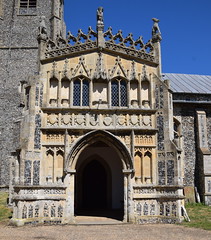 |
|
The Pulhams are large,
comfortable villages to the north of Diss, just
to the east of the Ipswich to Norwich road, and
about halfway between them, and so must have been
a regular stopping point in years gone by. As at
neighbouring Pulham Market, Pulham St Mary is
dominated by its grand, mostly Perpendicular
church, this one set on a rise above the village
street in a wide graveyard. There are
similarities between the two churches, but
differences too. St Mary's tower is earlier and
is rather more feminine, with its pretty
pinnacles and large bell openings. And, of course, there is the most
famous feature of either church, St Mary's
gorgeous late 15th century porch, perhaps the
best in Norfolk and the equal of many of
Suffolk's finest. Tower and porch work together
to create a sense of grandeur, but in fact this
is not a huge church, and there is no aisle on
the north side.
The porch is magnificent. Actually not as large
as it appears, its two storeys are flanked by
ranges of flushwork panelling, which become, from
the top on the front, ranks of stone niches,
angels holding shields, angels with musical
instruments and then more niches. The angels on
the west side play wind instruments, those to the
east play stringed instruments. Pride of place,
in the spandrels of the doorway, is the
Annunciation, of the highest artistic quality and
in lovely condition.
|
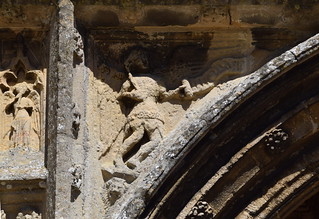 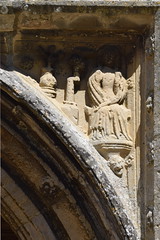
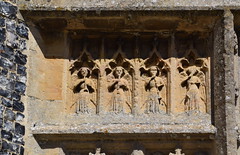 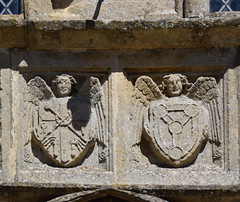 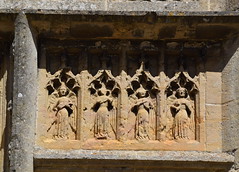
You step into an
interior which at first sight disappoints a little,
because the north side of the nave is stark, climbing as
it does to the heights of the clerestory opposite.
Pevsner records that Bodley's restoration cost an
astonishing £5,000, around a cool million in today's
money, and it is rather hard to see what they got for
their cash. The painting and gilding of the 15th century
font is an example; it is rich and opulent now, and you
aren't half glad this didn't happen more often, but it
seems to have been coloured to match Bodley's font cover,
as if he was looking for jobs to do.
However, we can't know what state such a large church
might have been in by the late 19th century, and turning
east, the picture is more pleasing, for Pulham St Mary
still has ranks of low key 15th century benches, which it
must have been tempting to replace. They face a
magnificent rood screen, partly medieval and partly the
work of Mr Bodley. Thanks be to God that he didn't
repaint the panels, for they are large and filled with
15th century images of the Apostles. St John is
particularly striking, the little dragon in his chalice
seemingly about to take flight. St James is fine too.
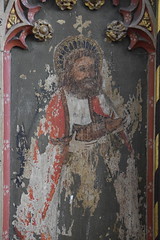 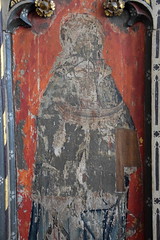 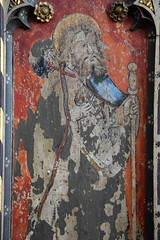  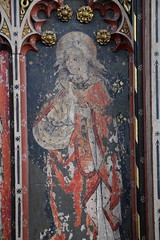 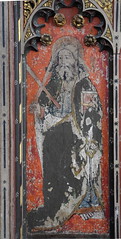
There is some
fragmentary 15th century glass, including two almost
complete figures of St Barbara and St Catherine. There is
a 16th Century roundel of St Lawrence high in the east
window. The Victorian glass is probably the largest
scheme in East Anglia by Burlison & Grylls, all in
their painterly style. A lot of the money probably went
on it. You can see a selection lower down this page.
Bodley had
the chancel roof repainted in reds and greens,
with sacred monograms. Some of these monograms
are more elaborate than others, and I wondered
for a moment if the simpler ones were actually
15th century originals. A cute skull and crossed
bones is incised on a ledger stone in the aisle,
its occupant reminding us that Hodie Mihi, Cras
Tibi - 'today this is mine, tomorrow it's yours'.
Turning west,
the most striking sight is the extraordinary
stairway up to the ringers' floor of the tower.
It starts in the most south-easterly corner of
the aisle, and rises with just a single rail to
reach a precipitous platform, dangled
nightmarishly at the top of the tower arch. There
is something similar under the crossing at Ketton
in Rutland. It must have replaced a ladder. I,
who have no head for heights, would not have
dared walk up it for all Mr Bodley's thousands.
|
|
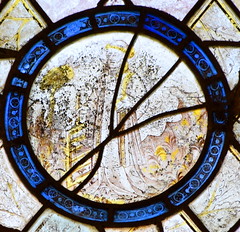 |
Simon Knott, August 2018
|
|
|
